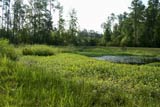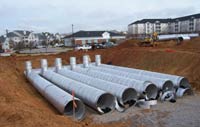
National vs. State Rules
It's best to understand both to avoid stormwater enforcement costs
- By Amos Clark
- Dec 11, 2008
Nationally established stormwater regulations can conflict with statewide enforcement and the trickle-down effect may leave local jurisdictions as well as developers confused about who is regulating what and why the regulations were organized in this way.
Most water quality legislation originated with the Federal Water Pollution Control Amendments of 1972, commonly known as the Clean Water Act. Over the next several years, Congress amended the legislation, forming the Clean Water Act of 1977 and the Water Quality Act of 1987. These groundbreaking laws are the basis for many variations of stormwater management requirements throughout the United States.
In many cases, the regulations mandated on the federal level are codified at the state level for implementation. In other cases, regulations are passed down even further, with states mandating that the rules be administered through locally adopted ordinances and codes. Following are several examples of how the federal-state regulatory system generally works in the stormwater arena.
 |
In this extended detention project in Durham, N.C., a stormwater wetland was used to meet water supply watershed requirements.
|
CWA Sections 401, 404
Wetlands are regulated under the Clean Water Act since protection of wetlands is also protection of surface water quality and habitat. Sections 401 and 404 protect surface water quality by limiting the disturbances of these areas. In many cases, permits under Section 401 require stormwater treatment as part of the permit. Section 401 is administered at the state level and Section 404 by the U.S. Army Corps of Engineers. Each of these sections must be satisfied before wetlands or jurisdictional water disturbances can take place.
For example, the Corps of Engineers may determine that an area of a particular parcel is not subject to wetlands requirements. The state, under the 401 program, can step in and determine that it is an area of isolated wetlands and regulate what can take place in that area. Thresholds of disturbance for specific permitting requirements can differ between the programs. Earning a permit for one program does not guarantee a permit from the other.
NPDES
The National Pollutant Discharge Elimination System (NPDES) requirements, established in 1972, were developed at the federal level, which directed the states to implement them as federal pollution control regulations that are often implemented at the state level.
In North Carolina, the state requires that stormwater regulations be codified and enforced at the local level through a series of permits issued to the local government entity by the state. Phase I and Phase II NPDES permits are issued by the state to each of the affected local jurisdictions. However, even though these permits are issued by the state to the appropriate local jurisdiction, that permittee is completely responsible for making sure that the requirements -- as codified on the federal level -- are satisfied by their permits and actions. Compliance with the state-issued permit may or may not guarantee that the local jurisdiction, that is, the permittee, is meeting the requirements mandated at the federal level.
 |
The Ambrose Creek stream restoration project in Surry County, N.C., required both Clean Water Act Sections 401 and 404 approvals. |
TMDLs
The state also requires specific stormwater regulations, including Total Maximum Daily Load (TMDL) programs, be implemented locally. TMDL programs in North Carolina require nutrient management strategies for the Tar-Pamlico and Neuse River basins and some are being proposed for Jordan Lake and are anticipated for Falls Lake. Other regulations include the Water Supply Watershed Program, put in place statewide in the late 1980s as a measure to protect drinking water supplies from contaminated runoff. For each of these sets of regulations, the state determines the “model” requirements that each local government entity must enforce as a minimum. The local government entity is then responsible for establishing a program for meeting those state minimums as well as enforcing them.
In some cases, projects that meet the state minimums are not necessarily compliant with federal regulations, such as the NPDES program.
While having federal, state, and local regulations to answer to is somewhat cumbersome, this regulatory sharing of duties does have its advantages.
By having the state mandate regulations to local governments, more funding may be available at the state level for studying specific areas where watershed problems may exist within a certain target area. This system also allows for problems outside of a local jurisdiction to be studied on an entire watershed area so that the actual problem can be addressed on a large scale. This provides continuity in how a basin or watershed is studied and, ultimately, managed.
The shared system provides a foundation for local governments to start their own stormwater control programs based on data that has been collected and analyzed on a watershed scale basis by the state or federal agencies. This data gives a basis for specific ordinance requirements.
Because mandates from the state typically are set as minimum requirements of the local entity, variations in the local regulations are allowed as long as the minimum requirements are met. This allows local governments to address known concerns when enacting its ordinances. For example, some cities enact flood control provisions (such as requiring downstream flooding analyses or flow attenuation devices) as part of their ordinances that meet state mandates.
 |
An underground treatment system was used to meet National Pollutant Discharge Elimination System stormwater requirements for the State Employees Credit Union in Raleigh, N.C.
|
Is it working?
Not surprisingly, working in this system can be difficult at times when, for example, state mandates are left up to local governments to establish, meet, and enforce. Local governments do not always have the funding or staff required to implement the mandates. In cases such as these, the local entities often have to scramble to find funding sources or risk being in non-compliance with the regulations, which could mean the loss of other sources of revenue. In some cases, the state can step in to provide administrative and technical support.
There also may be a “disconnect” in the system, when the regulations are passed down through multiple levels before reaching the final enforcement level. In NPDES regulations, the state determines the “model” requirements and serves as the permit issuance agency to the local government as well as the liaison to the U.S. Environmental Protection Agency. However, EPA has the authority to audit the local programs to ensure that there is compliance with federal regulations that the state permit might not meet. If the state-issued permit does not comply with the federal standards, the local government can be held responsible as the permittee.
Because each local government enacts its own regulations, there may be some variation between communities. Developers and others responsible for meeting the requirements of the regulations must not depend on plans that meet requirements in one jurisdiction to necessarily meet requirements in another. Significant differences can exist within the same watershed for projects that are literally across the street from one another.
Stormwater regulations can be complex both in the requirements that must be followed and in the administration of the regulations. Care must be taken to comply at all levels of enforcement. By doing this, we all are taking necessary steps to ensure that a balance between the environment and human impact is maintained and that we can preserve and stimulate economic growth while serving as stewards of the environment.
About the Author
Amos Clark is the director of EcoEngineering, a division of The John R. McAdams Company that provides specialized environmental and stormwater services to private and public clients of all sizes in North Carolina, South Carolina, and Virginia.